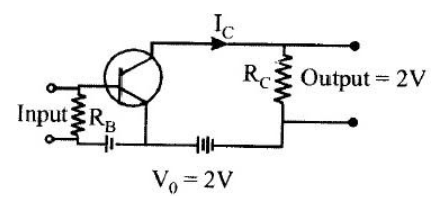
In a CE transistor amplifier, the audio signal voltage across the collector resistance of $2k\Omega $ is $2V$. If the base resistance is $1k\Omega $ and the current amplification of the transistor is $100$, the input signal voltage is
A) $2mV$
B) $3mV$
C) $10mV$
D) $0.1mV$
Answer
574.8k+ views
Hint: Use the formula of parameter $\beta $ $\left( {\beta= \dfrac{{{I_C}}}{{{I_B}}}} \right)$ for current gain. In common-emitter configuration of a NPN transistor, the input current ${I_B}$ is through the base junction, and the collector current ${I_C}$ is the output.
Complete step by step solution:

Here, voltage across the collector ${V_0} = 2V$
Base resistance ${R_B} = 1 \times {10^3}\Omega $
Collector resistance ${R_C} = 2 \times {10^3}\Omega $
And we have to find the input signal voltage.
The common emitter (CE) amplifier is used when the large current gain is needed. The input signal is applied between the base and emitter terminals whereas the output signal is taken between the collector and emitter terminals.
So we know, the voltage across the collector is
${V_0} = 2V$
Or ${V_0} = $(collector current) $ \times $(collector resistance)
Let the collector current be ${I_C}$
So, ${V_0} = {I_C}{R_C} = 2$
Since ${R_C} = 2 \times {10^3}$, therefore we calculate collector current as follows
$
{I_C} = \dfrac{{{V_0}}}{{{R_C}}} \\
\Rightarrow {I_C} = \dfrac{2}{{2 \times {{10}^3}}} = {10^{ - 3}} \\
$
Now, $\beta $ is the current gain or current amplification factor.
So $\beta= \dfrac{{{I_C}}}{{{I_B}}}$
Here, \[{I_C} = {10^{ - 3}}\]and \[\beta= 100\]
Therefore, to find base current as
\[
{I_B} = \dfrac{{{I_C}}}{\beta } \\
\Rightarrow {I_B} = \dfrac{{{{10}^{ - 3}}}}{{100}} = {10^{ - 5}}A \\
\]
Now let the input signal voltage is \[{V_i}\]
Since the base is input terminal, therefore
\[{V_i} = \](Base resistance) $ \times $ (Base current)
$ \Rightarrow {V_i} = {R_B}{I_B}$
By putting the value of ${R_B}$and${I_B}$, we get
\[
{V_i} = \left( {1 \times {{10}^3}} \right) \times \left( {{{10}^{ - 5}}} \right) \\
\Rightarrow {V_i} = {10^{3 - 5}} = {10^{ - 2}} = 0.1mV \\
\]
$\therefore$ The input signal voltage is $ 0.1mV$. Hence the correct option is (D).
Note:
The interesting thing to know about the CE transistor amplifier is that the emitter terminal is common for both input and output signals that’s why it is called a common emitter transistor. Moreover, the current gain of a transistor in CE configuration is high. Therefore, the transistor in CE configuration is used for amplifying the current.
Complete step by step solution:

Here, voltage across the collector ${V_0} = 2V$
Base resistance ${R_B} = 1 \times {10^3}\Omega $
Collector resistance ${R_C} = 2 \times {10^3}\Omega $
And we have to find the input signal voltage.
The common emitter (CE) amplifier is used when the large current gain is needed. The input signal is applied between the base and emitter terminals whereas the output signal is taken between the collector and emitter terminals.
So we know, the voltage across the collector is
${V_0} = 2V$
Or ${V_0} = $(collector current) $ \times $(collector resistance)
Let the collector current be ${I_C}$
So, ${V_0} = {I_C}{R_C} = 2$
Since ${R_C} = 2 \times {10^3}$, therefore we calculate collector current as follows
$
{I_C} = \dfrac{{{V_0}}}{{{R_C}}} \\
\Rightarrow {I_C} = \dfrac{2}{{2 \times {{10}^3}}} = {10^{ - 3}} \\
$
Now, $\beta $ is the current gain or current amplification factor.
So $\beta= \dfrac{{{I_C}}}{{{I_B}}}$
Here, \[{I_C} = {10^{ - 3}}\]and \[\beta= 100\]
Therefore, to find base current as
\[
{I_B} = \dfrac{{{I_C}}}{\beta } \\
\Rightarrow {I_B} = \dfrac{{{{10}^{ - 3}}}}{{100}} = {10^{ - 5}}A \\
\]
Now let the input signal voltage is \[{V_i}\]
Since the base is input terminal, therefore
\[{V_i} = \](Base resistance) $ \times $ (Base current)
$ \Rightarrow {V_i} = {R_B}{I_B}$
By putting the value of ${R_B}$and${I_B}$, we get
\[
{V_i} = \left( {1 \times {{10}^3}} \right) \times \left( {{{10}^{ - 5}}} \right) \\
\Rightarrow {V_i} = {10^{3 - 5}} = {10^{ - 2}} = 0.1mV \\
\]
$\therefore$ The input signal voltage is $ 0.1mV$. Hence the correct option is (D).
Note:
The interesting thing to know about the CE transistor amplifier is that the emitter terminal is common for both input and output signals that’s why it is called a common emitter transistor. Moreover, the current gain of a transistor in CE configuration is high. Therefore, the transistor in CE configuration is used for amplifying the current.
Recently Updated Pages
Master Class 12 Social Science: Engaging Questions & Answers for Success

Master Class 12 Physics: Engaging Questions & Answers for Success

Master Class 12 Maths: Engaging Questions & Answers for Success

Master Class 12 Economics: Engaging Questions & Answers for Success

Master Class 12 Chemistry: Engaging Questions & Answers for Success

Master Class 12 Business Studies: Engaging Questions & Answers for Success

Trending doubts
What are the major means of transport Explain each class 12 social science CBSE

Which are the Top 10 Largest Countries of the World?

Draw a labelled sketch of the human eye class 12 physics CBSE

How much time does it take to bleed after eating p class 12 biology CBSE

Explain sex determination in humans with line diag class 12 biology CBSE

Plot a graph between potential difference V and current class 12 physics CBSE




